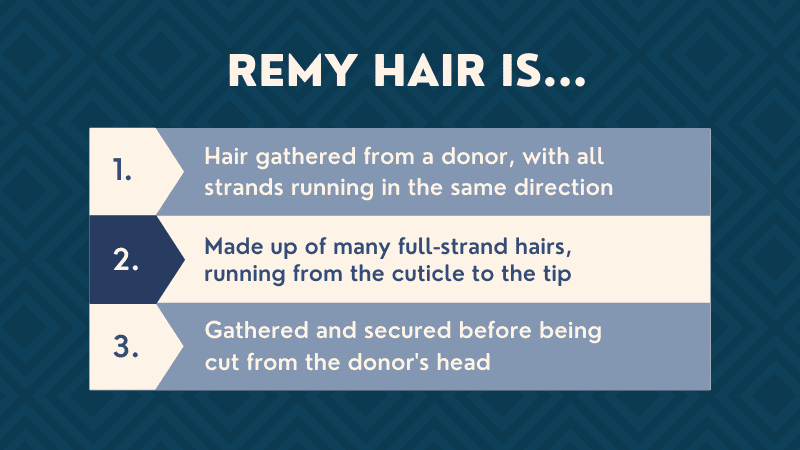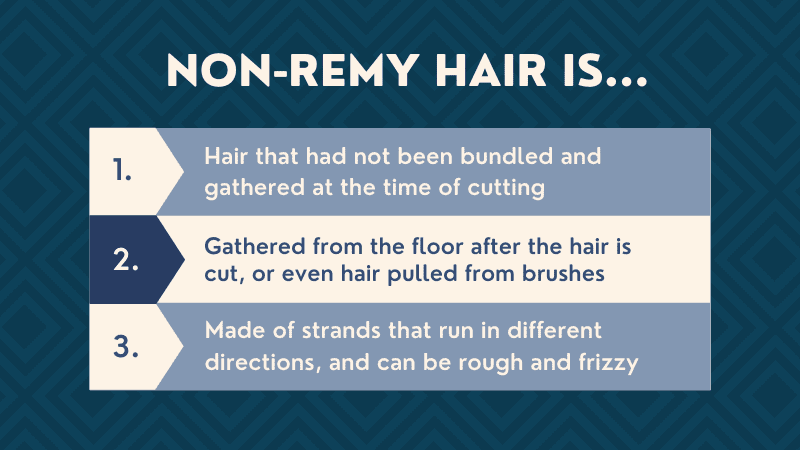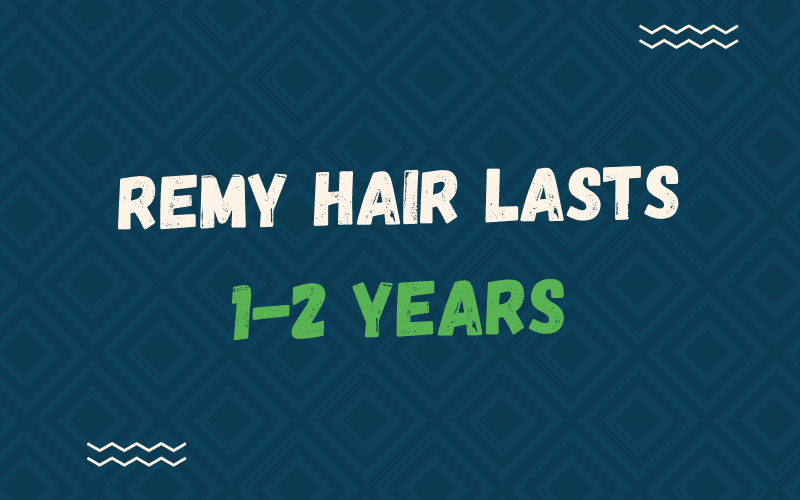Jump to:
Hair extensions can be confusing because there are so many different types of hair to choose from. Remy hair is considered the gold standard for human hair extensions. But what is Remy hair and how is it different from virgin hair? We break it all down for you in this guide.
What Is Remy Hair?
As soon as you start researching human hair extensions, you’re sure to see some confusing terminology. Remy hair! Remi hair! Virgin hair! Brazilian/Indian/Peruvian hair! These labels sound okay, but what do they actually mean? And which type of human hair extensions will look the best?
Remy hair, sometimes called Remi hair, is generally hailed as the gold standard of hair for human hair extensions. It’s often advertised as being higher quality, shinier, softer, and stronger than other types of human hair.
It tends to be a little more costly than other hair types, and it’s the most sought-after hair type for extensions. But only about 20% of hair extensions on the market are true Remy hair.
But Remy hair is probably not what you think. Remy hair has nothing to do with the hair being virgin, unprocessed, or super high-quality. The term actually refers to how the hair is gathered and processed.
More on that in a bit!
Today, we’re demystifying human hair extensions by covering the basics. You’ll learn what Remy and non-Remy hair are, how they’re different from virgin hair and yaki hair, the average cost, and what makes it the superior choice for hair extensions. Let’s get started
Read Next:
First…What’s Remy Hair?

Remy hair is human hair that has been gathered from a donor with the cuticle layer intact and all strands running the same direction (just like they naturally do on your head).
Because the outermost cuticle layer is intact with strands running the same way, Remy hair feels softer, looks shinier, and experiences less tangling, matting, and shedding. Not all human hair used in wigs and extensions is Remy hair.
For hair to be considered remy, it must be gathered together and secured before being cut from the donor’s head. Gathering the hair before cutting ensures all the strands are secured in the same direction.
This is why you see stylists pulling hair into an elastic before cutting when a client wants to donate to an organization like Locks of Love or Wigs for Kids. These organizations want Remy hair to make their wigs because it’s the highest quality.
What Is Non-Remy Hair?

When we talk about human hair extensions, there are two general types: Remy and non-Remy. We know that Remy hair is gathered and bundled before cutting to ensure all the strands run in the same direction.
This is what ensures smoothness, more shine, and fewer tangles. Non-Remy hair is human hair that hasn’t been gathered and bundled at the time of cutting.
If you swept up the hair off the floor after a haircut, it would be non-Remy hair. Non-Remy hair doesn’t have all the strands running in the same direction, and it’s not from a single source like Remy hair can be.
Instead, non-Remy hair may be gathered from the floor after hair is cut, taken from scrap hair used for other purposes, and can even be pulled from hairbrushes. This results in strands that are running in different directions that make it nearly impossible to detangle, brush, and style.
Non-Remy hair has these characteristics:
- Strands (and their cuticles) running in different directions
- Rough, frizzy texture
- Includes fallen and “scrap” hair
- Multiple donor sources
- Exposure to additional processing (acid bath, silicone coating, etc.)
- Tendency to shed, tangle, and mat
Manufacturers found that soaking non-Remy hair in an acid bath dissolves the outer cuticle layer and “solves” that problem. But the acid bath makes non-Remy hair feel like straw, so manufacturers added a second process where they coat the hair with silicones to make it temporarily look shiny and feel softer.
After a few shampoos, the silicone coating wears off, and you’re left with straw-like “scrap” hair extensions. Yuck.
Basically, when it comes to non-Remy hair, there are no holds barred. It could be from anywhere, anyone, or anything. This is why we strongly recommend sticking with verified Remy hair only.
Can You Dye Remy Hair?
If you want to change up the color of your extensions, you’ll be happy to know that you can dye Remy hair. Remy hair is human hair. This means you can treat it just like you would your natural hair. It can be dyed with a darker color or bleached to a lighter color.
It’s important to know that dying Remy hair does cause some damage to the individual strands, though. This is why many professionals recommend buying virgin Remy hair extensions if you plan to dye them.
Virgin Remy hair can better stand up to chemical processing without looking damaged. You shouldn’t dye synthetic hair extensions (those that are not made from human hair). Since hair dye contains harsh chemicals like ammonia or bleach, it will destroy synthetic extensions.
Can You Heat Style Remy Hair?
Yes, you can heat-style Remy hair! Remy hair is human hair, and it is safe to style with your favorite hot tool – flat iron, curling iron, hairdryer, wave iron, etc. Since Remy hair is human hair, you can do anything to it that you would normally do to your natural locks.
You should take the same precautions with Remy hair as you would with your own hair. That means using a good heat protectant before styling with hot tools, avoiding applying direct heat for too long, and avoiding exposing the hair to temperatures above 450 degrees Fahrenheit.
While you can definitely heat style Remy hair, you should not attempt to heat style synthetic hair extensions. You can melt or seriously damage the synthetic hair with the high temperatures hot tools reach.
How Long Do Remy Hair Extensions Last?

You can expect human hair extensions to last a year or more when they are properly cared for and maintained. Remy hair (which is human hair) will last a year plus if you take good care of it.
If you want your Remy hair extensions to last even longer, opt for virgin Remy hair. Virgin Remy hair can last up to 2 years when properly cared for and maintained.
We’ll talk more about virgin hair and Remy hair in the next section. One to two years doesn’t sound like a lot of time, but in the world of hair extensions, this is a great duration.
Synthetic extensions don’t last nearly as long as Remy hair extensions. You can expect synthetic extensions to last anywhere from 2-6 months, depending on how you care for them.
Remy Hair Vs. Virgin Hair
How does Remy hair compare with virgin hair? Virgin hair is human hair that has never been chemically processed (colored, relaxed, permed, highlighted, chemically straightened, etc.). It’s human hair in its “raw” form – 100% natural and never processed.
Remy hair can be virgin hair, but not all Remy hair is virgin. We mentioned that Remy hair has been gathered and secured in a bundle before being cut off. If the hair donor never dyed, bleached, permed, or chemically straightened or relaxed their hair, this would be virgin Remy hair.
That’s the gold standard for human hair extensions. If you want the best quality, virgin Remy hair is it. If the hair donor had any chemical processes done to their hair before donating – even just one – the hair is not considered virgin.
But as long as it’s gathered and secured into a bundle before it’s cut off, it’s still considered Remy hair. To recap, virgin hair refers to human hair that has never been chemically processed.
Remy hair refers to the way hair is gathered and bundled at the time of cutting. For the highest quality hair extensions, you’d ideally have both: Virgin, Remy hair.
Remy Hair Vs. Yaki Hair
Yaki hair is a popular choice in the extension and wig world. How do remy hair and yaki hair compare? Yaki hair can be made with Remy hair, but not all yaki hair is made with Remy or human hair at all.
Yaki hair was originally made with yak hair – seriously. But so many people were allergic to yak hair that manufacturers started using human hair (Remy or non-Remy) or synthetic. This kind of hair is processed to resemble the texture of chemically relaxed or natural African hair.
There are four basic types of yaki hair:
- Silky (straight, relaxed texture)
- Kinky (tightly coiled natural texture)
- Coarse (looser coiled natural texture)
- Regular (relaxed but not straight texture)
The process yaki hair goes through gives it a micro kink along each strand. These micro kinks give yaki hair more texture than other types of extensions. That’s what makes it look similar to natural, pressed, or relaxed hair with the coily texture.
So Remy hair can be used for yaki hair, but that’s not always the case. You’ll need to look for the words Remy hair or Remi hair on the package, but even then, it might not be Remy hair. There’s a ton of mislabeling due to a lack of hair extension industry standards.
How to Find Real Remy Hair

It’s undeniable that Remy hair is of the best quality. If you’re planning on getting extensions, Remy hair is the only way to go. But finding real Remy hair can be harder than it seems. A quick Google search will pull up thousands of products claiming to be Remy hair.
But, unfortunately, you can’t just trust that those labels are correct. There’s a lot of mislabeling in hair extensions due to a lack of industry regulations and standards. Hair extension packaging and labels are not always reliable.
It’s common for sellers to give non-Remy hair an acid bath and silicone coating, then sell the processed hair as Remy hair to command a higher price.
Unfortunately, it’s impossible to distinguish between Remy and processed non-Remy hair at first. After a few shampoos to remove any silicone coating, you would be able to see the obvious difference.
But that doesn’t help you when you’re trying to make sure you’re buying the real deal. What you can do is opt for virgin Remy hair instead. Since virgin hair has never been processed, trustworthy companies would never label non-Remy processed hair as virgin Remy hair.
You can be sure you’ll end up with real Remy hair when you buy virgin hair (as long as the virgin label is correct!). You should also find the most trustworthy outlets and websites to purchase your hair extensions from.
Look for lots of positive customer reviews, actively engaged customer service team members, normal pricing (nothing too low or crazy-high), and plenty of product information.
Good companies want to tell you where their human hair is sourced from, how it’s been processed (if it’s not virgin hair), how long it should last with good care, and recommendations for maintaining your extensions.
If you land on a website with limited info, lacking customer service, insanely low prices, lots of negative reviews (or positive reviews that seem fake), then focus your search elsewhere.
By choosing Remy hair for your extensions, you’re getting high-quality human hair that will look smoother, shinier, and more natural than non-Remy and synthetic hair. It will last longer and better blend with your own strands.
If you take it a step further and opt for virgin Remy hair, you’ll be getting the highest quality of human hair available. It’s more expensive, but can last up to 2 years. When it comes to what looks best, we think it’s worth it to splurge on virgin Remy hair.
